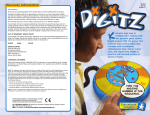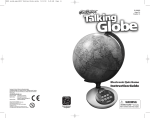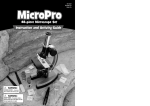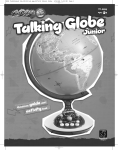Download Learning Resources Talking Electron Microscope
Transcript
Photo Credits The following images copyright Dennis Kunkel Microscopy, Inc.: hummingbird feather, plant cell, blade of grass, E. Coli bacteria on surface of small intestine, Anthrax virus, Northern house mosquito, yellow jacket wasp stinger, mucus and pollen grain on a nose hair, antibiotic treatment on E. Coli, Rhinovirus (common cold), surface of rockcress leaf, Velcro™ fastener, bone, broccoli floret, egg shell, red ant, housefly, skin of dogfish shark, tongue with papillae and taste buds, Diatoms, cat tongue papillae, moss spores on moss, blood, spinneret of spiny orb-weaver spider, pollen grains, bean weevil and bean seed, Salmonella bacteria, sperm and egg, pill bug, root of a germinating radish seed, sand grains, red spider mite, grasshopper head, scales on monarch butterfly, head of monarch butterfly, brown recluse spider, and rose petal The following images copyright CMSP, Inc.: human hair, window mold, cat hairs, cotton fibers, skin, cross section of a pine needle, cross section of a chrysan themum leaf, deer tick, greenbottle fly maggot on beef, streptococcus bacteria, dental floss with plaque, table salt, starch granules in wheat flour, cockroach leg, head louse on a human hair, dust mite, chromosomes, head of leech, newsprint paper, human eye, tongue with bacteria, blood-filled aorta, and animal cell EI-8803 Ages 8+ Grades 3+ ™ LCD screen to view microscopic images Focusing magnifier Quiz button Facts button On/Off button Volume button Select button Navigation arrows Home button Answer buttons The amazing Scanning Electron Microscope Most of the fantastic images in the Talking Electron Microscope were created with a Scanning Electron Microscope. Conventional microscopes use glass lenses to bend light to create a magnified image. The Scanning Electron Microscope bombards the image with electrons instead of light waves. The resulting images are super-detailed 3-dimensional images that are at much higher magnifications than can be accomplished with a light microscope. Developed in Southern California by Educational Insights. © Educational Insights, Inc., Gardena, CA (U.S.A.). All rights reserved. Learning Resources Ltd., King’s Lynn, Norfolk (U.K.). Please retain this information. Made in China. www.EducationalInsights.com 8803 guide.indd 2-3 The images in the Talking Electron Microscope reveal the amazing detail and complexity of living things and tiny structures in the world all around us. 10/22/10 2:23:08 PM 1. Push the on/off button to begin When you see the GeoSafari screen in the eyepiece, you’ll know that your Talking Electron Microscope is ready to use. 2. Pick a category Press select to learn about the first category. Press the up or down arrows to see the other categories and press select to choose one. • ANIMALS • VIRUSES AND BACTERIA • THE HUMAN BODY • “STUFF” Keep in mind.... • Forgot to turn it off? The Talking Electron Microscope will power down on its own. • Use the focusing dial to adjust the focus of the Talking Electron Microscope for individual use. Battery Installation GeoSafari Talking Electron Microscope uses three C batteries. 1.Carefully remove the screw to lift the battery compartment door, located on the bottom of the Talking Electron Microscope. • PLANTS 2.Install three fresh C batteries in the battery compartment, as shown. 3. Pick a game: Facts or Quiz • Do not use rechargeable batteries. • Non-rechargeable batteries are not to be recharged. • Do not mix old and new batteries. Press this button for Facts Press this button for Quiz • Do not mix different types of batteries: alkaline, standard (carbon zinc) or rechargeable (nickel – cadmium) batteries. 4. Pick a specimen Press select to learn about the first specimen. Press the up or down arrows to see the other specimens and press select to choose one. • Only batteries of the same or equivalent type are to be used. 5. HOME Press the home button anytime to return to the main category listing. • The supply terminals are not to be short-circuited. 6. Now the Talking Electron Microscope will begin with fun facts or a quiz! You may switch from Facts to Quiz at anytime by pressing the other button. To change specimens, press the HOME button. How to Reset If the microscope should malfunction, turn it off and then on again. If that doesn’t help, try inserting new batteries. Facts Each time you press the arrow keys in Facts mode, the Talking Electron Microscope will say an interesting fact about the image in the eyepiece. The display will automatically zoom and pan the image to focus on the part of the image that the fact is about. Quiz Each time you press the arrow keys in Quiz mode, the Talking Electron Microscope will ask a question. Some questions are True or False. Press A for true. Press B for false. Some questions are multiple choice. Listen to the question and select your choice A, B, or C. Look into the microscope for hints that will help you answer questions. The display will automatically zoom and pan the image to focus on the part of the image that the question is asking about. • Batteries must be inserted with the correct polarity. • Remove exhausted batteries from the unit. 3. Close the compartment door and tighten the screw. Cleaning Instructions Clean product with a damp or dry cloth. Do not immerse or spray any liquid or water on product. Note: This equipment has been tested and found to comply with the limits for a Class B digital device, pursuant to Part 15 of the FCC Rules. These limits are designed to provide reasonable protection against harmful interference in a residential installation. This equipment generates, uses, and can radiate radio frequency energy and, if not installed and used in accordance with the instructions, may cause harmful interference to radio communications. However, there is no guarantee that interference will not occur in a particular installation. If this equipment does cause harmful interference to radio or television reception, which can be determined by turning the equipment off and on, the user is encouraged to try to correct the interference by one or more of the following measures: • Reorient or relocate the receiving antenna. • Increase the separation between the equipment and receiver. • Connect the equipment into a different outlet from the receiver. • Consult the dealer or an experienced radio/TV technician for help. Note: The user is cautioned that changes and modifications made to the equipment without the approval of manufacturer could void the user’s authority to operate this equipment. 2 8803 guide.indd 2-3 3 10/22/10 2:23:13 PM Animals The Human Body Bean weevil and bean seed Northern house mosquito Brown recluse spider Spinneret of spiny orb-weaver spider Mucus and pollen grain on a nose hair Skin Bone Tongue with papillae and taste buds Head of monarch butterfly Scales on monarch butterfly Cockroach leg Pill bug Human eye Blood Blood-filled aorta Chromosomes Head louse on a human hair Cat tongue papillae Deer tick Skin of dogfish shark Sperm and egg Human hair Animal cell Greenbottle fly maggot on beef Hummingbird feather Red ant Housefly Dust mite Red spider mite Grasshopper head Yellow jacket wasp stinger Head of leech 4 8803 guide.indd 4-5 5 10/22/10 2:23:25 PM Plants Viruses and Bacteria Blade of grass Surface of rockcress leaf Rose petal Cross section of a pine needle Streptococcus bacteria Salmonella bacteria E. Coli Bacteria on surface of small intestine Broccoli floret Diatoms Moss spores on moss Plant cell Tongue with bacteria Antibiotic treatment on E. Coli Anthrax virus Rhinovirus (common cold) “Stuff” Pollen grains Cross section of a chrysan themum leaf Root of a germinating radish seed 6 8803 guide.indd 6-7 Table salt Velcro™ fastener Dental floss with plaque Sand grains Cat hairs Newsprint paper Egg shell Cotton fibers Window mold Starch granules in wheat flour 7 10/22/10 2:23:37 PM
















